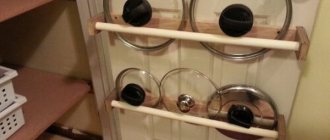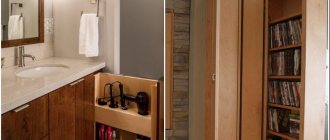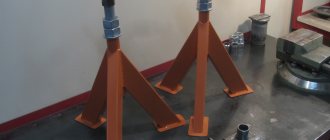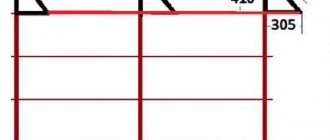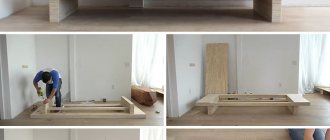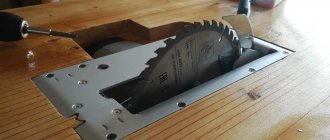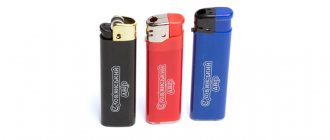Garden cabinet - for tools and more
This idea has been haunting me for a long time.
I really want to have a small cabinet for those tools that are constantly in use, so that I don’t have to go to the barn every time to get my favorite shovel, or to the house to get my pruning shears. Moreover, the design of such a structure is extremely simple, it is easy to build, and it does not take up much space. You can even rearrange a miniature storage unit if necessary - it’s no more difficult than moving a closet in your house. A garden cabinet can be quite small
Although, if desired, the cabinet can be made wider, more spacious and more massive, and on the door you can attach practical containers for all sorts of small things or a folding table, on which it is convenient, for example, to leave a box of seeds or your garden diary, so that you can keep the necessary notes immediately as you work .
A garden cabinet does not have to be a free-standing structure - you can attach it to the wall of a house or utility room. And good materials and thoughtful design will make this utility facility not only convenient, but also stylish.
A garden cabinet can be not only convenient, but also stylish
The internal space of the storage can also be organized to your taste: make shelves, hang hooks, equip stands if there are a lot of tools in it (for a couple of shovels, I think you can use stands and not bother). Such a structure will not replace a full-fledged shed, of course - it has a different role: it is a place where things that are constantly in use and should always be at hand are conveniently stored.
Planting cone for bulbs 270 RUB Russian Vegetable Garden Secateurs Classic 269 RUB Russian Vegetable Garden Narrow planting scoop with wooden handle 59 RUB Russian Vegetable Garden Garden rake with telescopic handle 170 cm. 500 RUB Russian Vegetable Garden
The self-taught self-made man rocked the network with his video
The self-taught inventor captivated the online community of craftsmen with his video, in which he presented a fundamentally new utility model for improving the efficiency of work for craftsmen and those who like to work in the garage. The best part is that it doesn't require you to buy an idea. And what’s more, you can do all this yourself and even a novice master can handle it. All this is to the benefit of every resident of the cities in which the masters have settled, because with such a high level of skill, now you won’t want to hammer the walls at home on weekends or rattle with some kind of ultra-decibel grinding machine of unknown purpose. With such a device, you can safely create your own separate workshop and live the rich life of a Russian craftsman.
Sealed containers for storing substances
Not only tools and equipment are stored at the dacha, but also construction mixtures, varnishes, paints, materials and reagents. Add fertilizers, sprayers, insecticides and other compounds to them. Breathing in the “aroma” of many of these substances is undesirable and sometimes harmful to humans. Therefore, they need to be stored in airtight containers, preferably tightly sealed containers. The “golden rule” applies here: “The more toxic the drug, the higher on the shelf it should be.” And of course, do not forget to always carefully study the storage conditions indicated on the labels of building mixtures, garden preparations and other substances. Some of them cannot tolerate negative temperatures, others cannot tolerate excess air humidity. All kinds of mixtures should be kept in original packaging or reliable and airtight containers. However, it is also better to store tools and parts in special suitcases or organizers.
As you can see, there are quite a few options for storing garden tools. It’s worth showing a little imagination, and instead of a chaotic warehouse of old things, you will have a beautiful and well-kept space in which everything is laid out in its place.
With the onset of warm weather, gardeners and gardeners take out tools and various household equipment from sheds and storerooms. In the midst of spring work, everything that a summer resident needs should be at his fingertips. There is a constant need for shovels, rakes, scoops, forks and pruning shears. On the one hand, they need to be as close as possible to the work site. On the other hand, I really don’t want the neat appearance of the area to be disturbed by objects scattered around! There is only one way out: you need to identify and equip a place for summer storage of tools. And in winter, they also have to be stored somewhere in order to meet the new summer season fully armed.
Garden decoration
We should not forget about the opportunity to become a designer of our own garden in the country. After all, you can make not only garden tools, but also much more. And to add some zest to your country house, you can lay out a beautiful and original garden path made of stone. Such a path will not only delight its owners, but will also become the latest trend, very popular among summer residents. For a stone path you will need:
- stone used to lay out the path;
- sand;
- gravel and board 25-30 mm thick.
Work should begin with a preliminary measurement of the distance of the future path. To do this, four pegs are driven in and connected in pairs with a guide rope. Afterwards, it is necessary to remove the top layer of soil, or in other words, dig a trench. When working with a shovel, one should not forget about the level of the trench, since it is better to make it even in depth. This will not only help to use building materials correctly and economically, but will also simplify subsequent work. You need to install boards along the edges of the trench; they will act as sides into which sand and stones are placed.
First of all, gravel should be poured into the bottom of the hole. It will not only perform a shock-absorbing function, but will also provide indispensable assistance in draining groundwater. Next, the gravel is covered with sand, which should be moistened in advance - this way it will lie more tightly. It is best to make a sand cushion with a thickness of 10 cm, and then you need to level the surface of the embankment with a board. Only after this can stone or paving stones be laid. It is necessary to calculate the thickness of the future path in advance so that you do not have to cut the stone again.
Metal boards for storing tools (pegboard)
A real find for lovers of a strict style in the category of “to have everything at hand” are sheets of metal with fine perforations. This results in double savings - both the tool is in sight and the workbench or desktop is always free. And this “wall perfectionism” also has advantages for forgetful or very generous owners. When all the tools are in place, you can immediately see what is missing, and you can either bring a forgotten tool from the garden or remind your neighbor to return the borrowed drill. Metal shields are equipped with numerous holes into which fasteners for various tools can be inserted. This system is suitable for both small and large rooms.
Neat storage cabinets
What gives a place for storing tools a sloppy appearance is not their quantity, but the fact that they are scattered haphazardly. This can be solved by installing wardrobes with sliding doors or even halves. You can’t imagine how many different devices, small items and large equipment can be stored there! An important advantage: the cabinets are on wheels and not on a static support, so their configuration and location can be changed. Of course, the internal placement of items, the height of shelves, the presence of hooks and other details can also be customized, creating a unique “interface” for storing tools. There are shelving units for sale for both large and small spaces.
Construction of a utility block - optimal area
On the one hand, such a structure does not take up much space on the site, on the other hand, does 0.2% exert any load on the remaining 99.8%, even if the site area is small - 6 acres? The answer is obvious - no.
Possibilities - the design serves only for its intended purpose or for other purposes (work in the workshop, taking a shower-toilet).
Availability of transport (the larger the vehicle, the more spare parts and consumables it has).
As a result, there is no specific area of the utility block that will suit everyone. After all, some people want to dine not far from the machine, while others love the space inside any room.
Obviously, the area of the utility room should not exceed the area of the living room and bathroom combined.
Plastic containers
Rack made of plastic containers.
From large plastic containers and pieces of wood, you can build a large rack for storing tools, wires, spare parts and any other things. Organizing such a rack will allow you to restore order and significantly save space in your workshop or garage.
Railings
Rails for garbage bags and paper towels.
On one of the free walls of the garage you can place several small rails on which you can conveniently place rolls of garbage bags, paper towels, sandpaper, tape, coils of rope and much more.
Furniture brackets
Brackets for storing furniture.
Many summer residents use the garage to store folding outdoor furniture. So that it does not stand in the corners and does not take up much space, make a vertical rack for it with wooden or metal brackets and screw it to one of the free walls.
Jars
Storage of nails, bolts, screws and other small items.
Bolts, nuts, nails, self-tapping screws, screws and other small things do not take up much space, but storing them mixed is extremely inconvenient. Jars with lids screwed to the bottom of a wall cabinet or under the desktop will help you put these things in order.
Ceiling grille
Grid for storing pipes and baseboards.
A plastic grid screwed into the corner of the garage under the ceiling is ideal for storing leftover water pipes, baseboards, profiles and other long items. Such a storage system will help significantly save space in the garage and prevent possible breakdowns of fragile building materials.
Screwdriver organizer
Wooden organizer for screwdrivers.
A small practical organizer for screwdrivers that any man can make by simply drilling the required number of small holes in a block of wood. This product can be hung on one of the walls of the garage or workshop to store all the screwdrivers in one place.
Vertical storage systems
Vertical panels for storing things.
Several perforated panels made of metal or plywood under a table or in a cabinet will provide an ergonomic and convenient place for vertical storage of small hand tools.
Plastic pipes
Storage systems made of PVC pipes.
Leftover PVC pipes of different diameters can be used to create a variety of storage systems. For example, pieces of wide pipe screwed to the bottom of the cabinet are suitable for storing a screwdriver, drill and other tools of this type. From pieces of medium-diameter PVC pipes you can make cells for storing various sprays, polyurethane foam, tubes of paint and other containers.
Tassels
Hanging storage for brushes.
It is very convenient to store paint brushes and spatulas suspended on a thin wire or on a thin steel rod.
Garden tool rack
Wooden rack for garden tools.
To prevent garden tools from taking up a good third of the garage space, store them on a special rack screwed to one of the walls. You can make such a rack yourself from blocks of wood, a wooden pallet or pieces of plastic pipes.
Multifunctional rack
Pallet rack with shelves.
A wooden pallet, complemented by shelves made from pieces of wooden slats, will become a functional component of the garage and will help to place a huge amount of hand tools and small ones in one place.
Fishing rod holder
A simple wire lattice can be used to create a convenient fishing rod holder. Such a storage system can be fixed under the ceiling so that it does not take up space below and does not get underfoot during the autumn-winter season.
Pegboard
Tool organizer made of perforated panel.
The perforated galvanized metal panel can be used to create a multi-functional wall organizer for all sorts of things. Using hooks and bolts on such a panel you can secure small hand tools, containers and containers.
Folding workbench
Folding wooden workbench.
A folding wooden workbench that can be made from wood is a great solution for a small garage or workshop. If necessary, such a workplace can be folded and attached to the wall, freeing up space for a car or other things.
Wheel bracket
Bracket for wheels in the garage.
A purchased or homemade bracket will allow you to securely fix a set of wheels under the ceiling or on one of the walls.
Video bonus:
Wooden holders
People who have at least minimal skills in working with a jigsaw can easily make a lot of convenient organizers and holders for a variety of things. A large number of such storage systems will allow you to put things in order in your workshop or garage and have a clear idea of where this or that item is located.
Source: https://sovet-ok.ru/17-genialnyx-idej-kotorye-pomogut-navesti-poryadok-v-garazhe/
Optimal storage conditions
When storing a beekeeping product, it is necessary to create the necessary conditions to minimize losses associated with spoilage and loss of beneficial qualities.
It is important to protect pollen from contamination by bacteria and fungi
To preserve the healing properties, the raw materials are placed in glass containers with a tight lid. The container is first sterilized and dried. Keep the filled container away from sunlight, high temperatures and high humidity. You can store pollen at room temperature or in the refrigerator. The bulk substance cannot be frozen, since at sub-zero temperatures it loses its beneficial properties.
Prepared pollen after drying and sifting is stored for up to two years. The period depends on storage conditions. Even if all conditions are met, a natural product loses 40% of its usefulness within a year. Therefore, within two years, at the end of the shelf life, only the protein compound is valuable. There are practically no vitamins and minerals in the composition.
DIY shelf!
Take a board that is at least a meter long and at least 4 cm thick; You will also need some remnants of boards and various planks, plywood trims in the shape of a triangle, of the same size.
Make grooves in each triangle the same size as the largest board. Connect the triangles to the planks using self-tapping screws. The edges need to be filed down. And as a result, you will get each of the triangles as a console.
Next, all consoles should be individually attached to a large board using self-tapping screws. During this process, make sure that the equipment can be hung upward with the working part. Insert boards between the consoles
This is important for imparting rigidity.
As a result of the work done, you will get a fairly heavy shelf that cannot be attached to the surface of the wall of the room without an assistant.
In fact, there are a lot of options for how to store tools in the country. And no one forbids you to fantasize and create your own ideas. A very interesting option for storing equipment is organizing a garden organizer.
KONICA MINOLTA DIGITAL CAMERA
And so that you don’t have to run for new garden tools at the beginning of each season, be vigilant and observe the correct storage conditions for your tools. Carefully consider your storage system so that they are reliably protected not only during the season, but also during frosts.
Original wall mounts
Here is perhaps the quickest and simplest idea: take an old garden hose and attach it to the wall so that the cuttings of garden tools can be inserted into the resulting “loops”. All! I would perhaps improve the idea a little by laying the hose not in one, but in two rows, one under the other - this way our equipment will be more stable.
An old hose will still serve: a mount for equipment that can be made in a few minutes. It will take a little more time to make mounts from pipe scraps. Well, the idea with construction buckets seemed worthy of attention to me. Although in this case the durability of the structure is questionable: with constant use, the upper buckets will most likely quickly become unusable.
It's all about: fastenings for tools from pipe scraps and construction buckets
But the main thing here is the idea, and then you can creatively develop it: for example, take not plastic buckets, but old galvanized ones - they are much stronger...
Mobile box
A cube-shaped wooden structure is an interesting and aesthetic way to store garden tools. The base of the box is three shelves with perforation. The holes provide stability for equipment with long handles. There are hooks on the sides for various small items, and furniture wheels are attached at the bottom, which help you move the box to any place.
Garden organizer made easy
For a simple garden organizer, we won’t need extra effort or significant financial costs. It's quite simple!
We will need four edged boards 25 mm thick. They need to be prepared for work - planed. The picture shows where the holes will be placed on the two boards. Let's outline them. Using a feather drill, we will make holes according to preliminary markings and then, using a jigsaw or a simple hacksaw, we will cut out the side cuts.
There is nothing complicated about assembling such an organizer. This simple process is reflected in sufficient detail in these pictures.
Let's connect the boards in pairs with self-tapping screws to make two L-shaped structures. Now we have two vertical posts. We choose the wall on which our organizer will be placed. Let it be, for example, the outer wall of any outbuilding. The racks need to be screwed to it parallel to each other at a shorter distance than the length of the shovel handle.
Why not show off such a worthy result of your work? It's always nice when your tools are kept in order. Work will be more fun with clean equipment
The work is finished. All that remains is to place all your equipment in the organizer and be glad that it will always be in order.
How to make a marker for sowing seeds
A homemade two-row marker allows me to significantly speed up the process of sowing seeds. Hilling potatoes with a hand hiller gave me this idea; people also call it an “eared” hiller. In essence, the marker is a smaller copy of it. During the tests, I finalized the design and I would like to tell you about the final result.
The rows made with a marker turn out smooth, and the work is pleasantly easy. The row depth can be adjusted by pressing on the marker handle, and the width between the rows can be adjusted by rearranging the marker plows on the base.
The marker is made of stainless steel. A half-inch pipe was taken as a base and a cone for the handle was welded perpendicular to it. Small gussets are welded between the pipe and the cone for structural rigidity. Holes are drilled along the edges of the pipe to change the width between the rows. Plows are inserted into these holes. They are made according to a template from two identical halves. The two halves are bent so that they touch in the middle and welded together.
To attach the plows to the frame, I took a metal rod with a diameter of 10 mm. I welded one side vertically to the plow, and on the other side I cut a thread and screwed it to the pipe with nuts. The handle is an ordinary wooden one, 150-170 cm long.
That's basically it. If you are not able to make this product yourself, then there will definitely be a craftsman nearby who can do all this, guided by the drawings I provided.
Making a shelf with your own hands
There are many ways to make a simple DIY tool rack. We bring to your attention one of them. For the base of the shelf we need one board over 1 meter long and 40 mm thick. In addition, we will prepare the remains of boards, planks, as well as identical trimmings of triangular plywood.
We take plywood triangles and cut out a groove on each of them with a jigsaw, corresponding to the board that we prepared for the base of the shelf. We screw the trim strips to the triangles with self-tapping screws and file off their edges. Now each triangle is a console.
This shelf is not difficult to make: to create it there is no point in buying new materials, you can use those left over from previous construction work
Using self-tapping screws, we fix each console to the base board so that shovels, rakes and other tools can be hung with the working part up. Cutting boards or chipboards should be inserted between the consoles. This will give the overall structure the necessary rigidity.
It must be said that the finished structure is quite heavy. To secure such a shelf to the wall, you need an assistant to support it. If the master works alone, then it is easier for him to initially secure the support board, and only then screw the consoles and elements that provide rigidity to it.
The only difficulty is the weight of the shelf itself, which will be a problem if you have to attach it to the wall alone, but in this case there is a way out
Another option involves securing the finished structure with one large nail, and then the final installation with self-tapping screws. In their locations, you can make through holes in advance. The resulting simple shelf collects all the main equipment.
Rammer
If you want to get a good harvest (and this is the dream of all summer residents), you need to start with the correct sowing of seeds. The basis for good growth is a strong root system. Its health depends precisely on how you carried out the sowing. To ensure a strong root system, seeds must be sown on compacted soil. For this purpose, a tamper is useful, which you can easily make with your own hands.
In design, it resembles a regular wooden mop for washing floors. The only difference is in the lower part: for a mop this part is flat, but for a rammer it should be semicircular, resembling a rolling pin or handle cut lengthwise.
To work, you will need a wooden handle, a semicircular board for the bottom, 2 small parts for stops and several screws to connect the main elements.
Mark a row and compact the soil along its entire length with a hand-made tool, and then begin sowing.
Storage of garden tools and other things at the dacha
As a rule, a country house, the area around it and all outbuildings resemble a warehouse for the temporary storage of various tools, gardening and sports equipment, and seasonal items. In this case, the main task that faces the owners is to organize the space on the site in such a way that the environment on it becomes functional, and the work brings only pleasure, without unnecessary expenditure of effort and time.
You should not clutter up your country house and outbuildings with broken things, because, most often, there is not enough time to fix them. Therefore, it would be more expedient if the necessary tools take the place of broken things. First of all, you should get rid of rusty equipment, broken boxes, old cans of paint and expired fertilizers and various chemicals, old, worn-out gloves and broken equipment. This will help free up additional space for convenient storage of things and garden tools in the country.
Garden Tool Storage: Ideas
Throughout the year, you need to take care of your summer cottage: loosen and level the soil, replant flowers, harvest, and remove fallen leaves. Therefore, gardening tools must always be kept in good condition.
Special attention should be paid to storing garden tools. Each piece of gardening equipment must occupy a specially designated place for it.
For example, to store equipment, you can build a wall-mounted container from boards, in which you can make several compartments of suitable width and depth so that the sharp parts of the tools occupy a safe position.
Rakes, shovels and forks can be stored on the wall of a garage or shed if you attach special hook holders to it. For gardening tools that are stored outside, it is necessary to make a container with a canopy. This will prevent moisture from getting on the tools and rust from forming on the metal parts of the equipment.
Tire craft ideas
Old tires on a summer cottage are a unique material. This is understandable, just look at the various photos of homemade items for the garden. You can use them not only to make a pond or use them to fence flower beds:
- halves of tires dug vertically can become an “obstacle course” on the playground: walking on them will become training for balance and coordination of movement for young athletes;
- You can make garden furniture from small-diameter tires: just build a wooden tabletop, and the seats can be woven from rope. Having made a wooden frame, you can make a chair in the same way;
- If you cut a tire in half and attach a seat board, you get a rocking chair. Paint it in a bright color and the children will be happy.
When the summer season is over
When cold weather sets in and work at the dacha is curtailed, it’s time to preserve the tools that have served us faithfully and send them for storage. If we follow all the rules, in the spring we will not have to spend money on buying a new one. Spring expenses are already high.
All shovels, hoes, rakes and other gardening tools should be preserved. We will conduct an initial inspection and repair anything that has broken down during the working season. Dirt and rust must be removed. Cleaning is best done with a wire brush or spatula. Lubricate the cutting edge and metal surfaces with oil.
Tools should not be left dirty and ungreased during the winter. All the same, we will have to do the same work ourselves in the spring. And in the spring, as you yourself know, there is a lot to do without it
It is necessary to sharpen the blades of the loppers and pruning shears. To remove nicks from the blade of a lopper or garden saw, use a file. A sharpening stone is better suited for pruning shears for the same purpose. You also need to take care of the wooden handles. They are also thoroughly cleaned, after which they are generously lubricated with ordinary sunflower or linseed oil. Handles impregnated in this way will not dry out and will last a long time.
Particular attention should be paid to the fertilizer sprayer. It is cleaned, thoroughly washed and dried
All levers and fastenings of the device are thoroughly coated with machine oil. Free the hoses from any remaining water, roll them into a ring and hang them on the wall. They should only be stored indoors.
A well-equipped summer cottage cannot do without electromechanical equipment. When preparing it for winter, the following steps are necessary:
- draining all excess fuel;
- changing engine oil;
- checking the availability of fasteners (brackets, plugs, screws) and making up for actual shortages.
Power cords also require mandatory inspection. If the integrity is broken, it is better to replace them with new ones. The trimmer head is cleaned, washed and dried. The mower blades are sharpened and lubricated. Both the electric shears and the herb chopper need cleaning. All knives, metal parts and movable joints of various units must be cleaned and lubricated.
Any electromechanical devices require careful care. But the life of a gardener and gardener is greatly simplified if he has them and is in good condition
Under no circumstances should the tool be left where it could get wet by rain or covered with snow. Even moisture from fog negatively affects its performance properties. The ideal storage location would be a special utility room. If there is no such room, a workshop or even a storage room in the house will do. Carefully preserved gardening equipment will successfully survive the period of lack of demand and will not let its owners down in the spring.
Storing garden tools vertically
The device for vertical placement of garden tools looks somewhat simpler. You can also use a wall.
There are many mounting options. From simple hanging to using tubes. The pros and cons here are the same as on the Swedish wall above. Everything is in sight, good access, but it takes up a lot of wall space.
The option of storing garden tools in a special device that resembles a box, divided from the inside into sections, looks more economical in terms of space occupied. The design can be different, it can be clearly seen in the photographs below.
One of the disadvantages of this design is difficult access to the tools located in the center. You will have to pull it out from many neighboring ones, which may not always be convenient and can be fraught with injury.
Storage of small garden tools
So far we have been talking about organizing the storage of large garden tools, such as shovels, forks, rakes, etc.
But there are also small spades, pruning shears and other “trifles”. You can make small shelves and holders for them (photo below).
For longer storage, it is recommended to use a container filled with sand with a small addition of vegetable oil. It is better not to use machine oil, since there is a risk of introducing it into the soil, and we do not want this. It is better to use linseed oil.
Just stick the tool into the sand and that's it. Of course, the storage must be dry, otherwise your tools are in danger of rusting.
As for storing watering hoses, it is not recommended to store them hanging on thin holders.
Under their own weight, they can sag and become broken at the point where they hang. An interesting option in the photo below.
Screw an old bucket or pan with its bottom to the wall. Original and convenient. And the internal volume of the bucket can be used as a shelf for every little thing.
However, the hoses can be stored rolled up and lying down.
You can read how to prepare your garden tools for winter storage.
Usually, country equipment is simply stored in a barn or basement. It is difficult to achieve order with this storage method, and it is not easy to quickly find the right thing. Isn't it time to clean up your property? We'll give you some valuable ideas.
Often a country barn or basement is a real secret room, the contents of which are almost unknown even to its owner. What is there: garden tools, equipment, old furniture, a set of summer or winter tires, spare parts for a car, building materials, power tools, etc. To find something, you need to carry out real excavations. Therefore, to help summer residents, special techniques were invented and systems for storing equipment were developed.
Methods for extending shelf life
Preservation will help preserve the usefulness and extend the shelf life of the bee product. The pollen is mixed with honey in a 1:1 ratio. The apiproduct is stored in a cool, dark place, away from sunlight and humidity. The pollen is first crushed with a coffee grinder or blender, then mixed with honey. The shelf life in this case reaches up to 5 years.
Flower pollen mixed with honey makes the product more palatable. In combination, two useful components only enhance their healing properties. The mixture becomes richer in the amount of vitamins and nutrients.
Pollen is a storehouse of medicinal properties for human health. In the absence of allergies, it is recommended not only for the treatment of a number of diseases, but also for the prevention of illnesses.
Share link:
Mount for secateurs and scissors
This holder fits tools with a wide base. The board is secured with two screws. The width of the board and the distance to the wall are determined based on the size of the equipment. The mount for the pruning shears is made in a similar way. In this case, the board to be attached is wider and is secured with four screws, which guarantees that the scissors are held firmly.
Garden toilet...for tools
If there is not much space on your site, and a large barn will take a considerable part of the fertile land out of use, you can build or purchase a small, “individual” room for equipment. An ordinary country toilet is quite suitable for this role. Considering that most of the garden tools are long rakes, shovels, hoes, hoes, etc., it is best to store them not in a long room, but in a high room. Such a booth can be slightly modified and, depending on the number of tools available, nail several hooks to the door, hang shelves or install a vertical stand. A small storage room can also be adapted for the same purposes.
Wood can withstand anything
Everything ingenious is simple! Wooden pegs are a great solution for our hanger. They can be used to store a shovel with a T-shaped handle, an electrical extension cord and garden shears for trimming branches. The diameter of the pegs is 15 mm. It is better to slightly round off their edges with sandpaper.
The base is a support for tools with long shafts - shovels, forks, rakes, etc.
Where to store equipment and equipment
Option 1. In the barn
- Large items (most often garden equipment) are placed on the floor, preferably at the entrance - in case something is urgently needed in winter (for example,).
- Small equipment, as noted above, is stored hanging on hooks or in containers (possibly in) attached to the wall. The order of arrangement depends on the frequency of use. A hoe is unlikely to be needed in winter, but a shovel is absolutely necessary. Even if you have a special shovel for cleaning, an extra one can always come in handy.
Option 2. In the garage
Equipment stored in the garage should not harm the car. Therefore, you should not place it closely
to the parking lot of the iron horse (minimum distance – 1 meter). You shouldn't hang it too high or too close either. Imagine for a second your favorite car and a pitchfork or rake flying at it... An unpleasant picture! Anything can happen, sometimes even the most reliable fasteners and hooks fall off, so it’s better to be safe.
Option 3. Give for special storage
Interesting:
Such warehouses are not very common in Russia. In Europe, on the contrary, the self-storage service is very popular, because Europeans value every free square meter and will not tolerate, even temporarily, extra boxes, containers and other things in a house or apartment.
In case you decide to try temporary storage, please note:
- on the company's reputation,
- on how long she has been storing things,
- as well as what types of storage it provides.
Floor installation in a barn
- If the barn is not built on the ground, not on a concrete slab, but on a pile or columnar foundation, logs should first be laid on the framing beam to form a warm and dry floor;
- After forcing out the walls, or at the same time, a subfloor and additional sheathing are laid, providing a base for the main floor and cells for laying insulation inside;
- Afterwards, mineral wool, a vapor barrier layer, and a floor base are laid, the material for which can be OSB, plywood sheet, or standard wooden floorboard!
